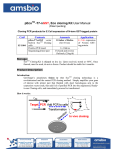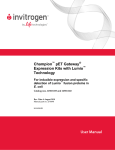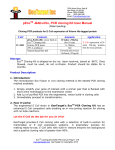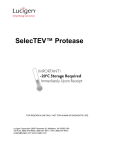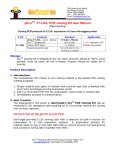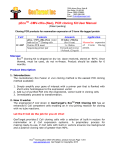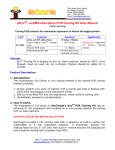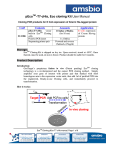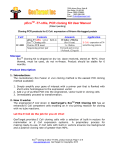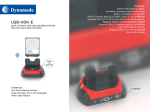Download pEco™-T7-nGST PCR Cloning kit
Transcript
7930 Arjons Drive, Suite B San Diego, CA 92126 Phone: (858) 6788683 Fax: (800) 3804198 Email: [email protected] pEcoTM -T7-nGST, PCR cloning Kit User Manual (Patent pending) Cloning PCR products for E Coli. expression of C-term His-tagged protein Cat# IC-1004 Contents Amounts pEco-T7-nGST vector built-in EcoTM Cloning cells Positive PCR insert Sequencing primer pair 10 tubes x 50ul/ea (for 10 rxn) 1 x 10ul/ea Forward and reverse 15ul/each, (25ng/ul) Application E Coli. expression of Nterm GST-tag protein. Storage: EcoTM Cloning Kit is shipped on dry ice. Upon received, stored at -80°C. Once thawed, must be used, do not re-freeze. Product should be stable for 6 months. Product Description: 1. Introduction: The revolutionary Eco Fusion in vivo cloning method is the easiest PCR cloning method available: 1. Simply amplify your gene of interest with a primer pair that is flanked with short arms homologous to the expression vector 2. Add 2 µl of purified PCR into the engineered, vector build-in cloning cells 3. Immediately proceed to transformation. 2. How it works: The engineered E Coli strain in GenTarget’s EcoTM PCR Cloning Kit has an enhanced E Coli competent cells enabling an in vivo joining reaction for cloning with no tube reactions. Let the E Coli do the job for you In Vivo! GenTarget provides E Coli cloning cells with a selection of built-in vectors for mammalian or E Coli expression systems. A proprietary process for making ready-to-use, E Coli cells with built-in vectors ensures low background and a positive cloning rate of greater than 90%. TM Eco Cloning of pEco-T7-nGST, product manual, Page 1 of 8 www.gentarget.com GenTarget Inc Copyrights, 2015 7930 Arjons Drive, Suite B San Diego, CA 92126 Phone: (858) 6788683 Fax: (800) 3804198 Email: [email protected] Target PCR Add PCR to cells Transformation n tio c In vivo cloning le e S pEco-T7-nGST cloning cells was built-in with a pET based T7 expression vector. PCR insert will be cloned in-framed with a N-terminal GST-tag. 3. Key Features: The easiest and most cost-effective PCR cloning method available. Simply add 1µl of PCR insert into provided cells for transformation regardless of the insert’s size and concentration No need to buy vectors and no tedious bench work preparing a vector backbone No need to buy cloning competent cells No need for any enzymes or any tube reactions Precisely directional cloning of PCR products with an in frame GST-tag at N-term. Flexibility to allow addition of any cleavage site for removal of the nGST tag if desired Compatibility with any PCR product with or without a 3’ -A overhang (the extra -A overhang, if it exists, will be removed in the cloning step) Can be used with PCR products of varying sizes, from 200 bp to 10 kb. The same PCR product can be used to construct multiple different expression vectors Engineered E Coli expression vectors for high protein yields Great for high throughput cloning 4. Protocol Outline: TM Eco Cloning of pEco-T7-nGST, product manual, Page 2 of 8 www.gentarget.com GenTarget Inc Copyrights, 2015 7930 Arjons Drive, Suite B San Diego, CA 92126 Phone: (858) 6788683 Fax: (800) 3804198 Email: [email protected] Produce and clean PCR products Add 1-2 µl of PCR product into the cloning cells provided; briefly mix and immediately proceed to transformation Pick colonies, save glycerol stocks, and isolate plasmids by miniprep to verify the positive clones Express protein from the saved glycerol stock 5. Detailed Protocol: 1. PCR primer design: PCR primers used for generating inserts for EcoTM Cloning must contain a 20 - 25bp homologous sequence corresponding to the built-in vector. Design your primer pair as follows: Fwd: 5’- atcggatctggttccgcgtgaattc + 20bp of (5’end gene specific forward sequence) Rev: 5’- ttgttagcaggttaacacgcgtcta + 20bp of (3’-end gene specific reverse sequence) A protein cleavage site may be included in the forward primer to allow excision of the N-term tag if desired. Its codon sequences must be in frame and set between the homologous leader and the 20bp gene specific sequence. An example of PCR primer design: To design the primer pair for the following gene sequence: atggcctctgtgaaggaaaatccactctagtccctacctgcatttctcagccttgct tacctgttgccaacattgggccaacccgaattcttcccaatctttatcttggctgcca gcgagatgtcctcaacaaggagctgatgcagcagaatgggattggttatgtgtta aatgccagcaatacctgtccaaagcctgacttttta The PCR primer for vector pEco-T7-nGST will be: Fwd: 5’- atcggatctggttccgcgtgaattcatggcctctgtgaaggaaaa Rev: 5’- ttgttagcaggttaacacgcgtctaaaagtcaggctttggacagg If inserting a protein cleavage site, the foward primer will be: TM Eco Cloning of pEco-T7-nGST, product manual, Page 3 of 8 www.gentarget.com GenTarget Inc Copyrights, 2015 7930 Arjons Drive, Suite B San Diego, CA 92126 Phone: (858) 6788683 Fax: (800) 3804198 Email: [email protected] Fwd: 5’ atcggatctggttccgcgtgaattcNNNNNNgcctctgtgaaggaaaatcc (where the NNNNNN is the in-framed codon sequence of cleavage site). Notes: 1. GenTarget’s cloning kits with the same terminal tags share PCR insert sites. The three EcoTM cloning kits with N-terminal tags, Cat# IC-1001, IC-1002 and IC-1003, can share the same PCR insert, and the two cloning kits with C-terminal tags, Cat#: IC-1006 and IC-1007, can share the same PCR insert. 2. A stop codon does not need to be included in the PCR reverse primer since a stop codon is already built in immediately after the PCR insert. 2. Target amplification by PCR: Amplify your target using any PCR amplification protocol that works for you. To minimize PCR errors, we recommend using high fidelity DNA polymerase. Use any PCR purification column to clean your PCR products. If you do not obtain a single, discrete band from PCR, gel purify your fragment. Important: if your PCR template can generate background clones having Amp resistance, treat the PCR product with DPNI or perform gel purification. 3. Transformation: Thaw EcoTM Cloning cells in ice-water. After they are completely thawed, add 1-2 µl purified PCR product (from 20ng to 150ng) into each vial of cells, and mix briefly by tapping the tube with your finger. For control vials, add 1µl positive PCR-insert (provided) as a positive control, and then add µl water to a negative control cells vial. Put tubes back on ice and proceed to heat shock at 42 oC for 40 seconds. (Note: Do not leave DNA-cells mixture on ice for prolonged period, less than 15min are fine). Put tubes back on ice for 1 min, add 250 µl of SOC medium, and incubate at 37 oC, shaking for 1hr. Plating: take a ~250 µl competent cells above, spread out on prewarmed LB-agar plates containing 100 μg/ml ampicillin. Grow colonies at 37 oC overnight. TM Eco Cloning of pEco-T7-nGST, product manual, Page 4 of 8 www.gentarget.com GenTarget Inc Copyrights, 2015 7930 Arjons Drive, Suite B San Diego, CA 92126 Phone: (858) 6788683 Fax: (800) 3804198 Email: [email protected] Note: In the absence of a PCR-insert, cells usually form background colonies; the no-insert negative control also generates a few colonies. In the presence of PCR insert, however, > 90% colonies are positive. Colony number varies depending on the quality and quantity of the PCR products. The concentration of purified PCR product can be from 20 ng/µl to 150 ng/µl with sizes ranging from 200 bp to 10 kb. For simplicity (and particularly for high throughput cloning) we recommend adding 1-2 µl of PCR product into the cloning cells. Regardless of the PCR product’s concentration and size, it will generate enough colonies (5 ~ 100 colonies in general) for downstream work. 4. Save glycerol stocks for later expression and verification of positive clones: Pick 2-5 colonies; propagate in LB/Amp, and incubate at 37 oC overnight Save an aliquot of each clone in LB-Glycerol medium containing 100 µg/ml ampicillin at a final concentration of 15% Glycerol. Isolate the plasmid DNAs using a DNA miniprep kit Confirm the positive by restriction digestion: PCR inset can be cut out by EcoRI + HpaI: Run 1.2% agarose, the positive clones will show two bands: 3.4 kb backbone + the PCR insert (or multiple bands when the cut exist within the PCR-insert). Final sequencing verification. Use the provided sequencing primer pair. The sequencing primer comes in a ready-to-use dilution: use 1µl for each sequencing reaction with 500ng plasmid in 20µl volume. Cat # IC-1004 Vector pEco-T7-nGST Forward primer IC-1004-fwd 5’- catggcctttgcagggct Reverse primer IC-1004-rev 5’- tgctagttattgctcagcgg 5. Protein expression: Once positive clones are confirmed, they can be used directly for protein expression without re-transformation into another strain. Transformation: transform the sequencing verified plasmid DNA into any strain containing a T7 RNA polymerase, such as BL21(DE3) or BL21(DE3)pLys from which protein are expressed upon IPTG induction. Transformation uses standard heat-shock protocol, such as add 1ul DNA into 50ul competent cell, set ice (5~15min), heat-shock at 42oC for 30 seconds, back to ice for 2min, add 250ul SOC, recovery at 37oC, TM Eco Cloning of pEco-T7-nGST, product manual, Page 5 of 8 www.gentarget.com GenTarget Inc Copyrights, 2015 7930 Arjons Drive, Suite B San Diego, CA 92126 Phone: (858) 6788683 Fax: (800) 3804198 Email: [email protected] shaking for 1 hour. Plate 10 to 100ul onto LB plates containing 100ug/ml ampicillin. Grow colonies at 37oC incubator for overnight; Propagation: Pick one clone, grow in LB medium with ampicillin at 37oC, shaking overnight. Add overnight culture into appropriate amount of LB medium containing 100ug/ml of ampicillin by making 1:40 dilution, keep medium volume at 20% of flask volume for better aeration, vigorously shake at 30oC, 300rpm; Induction: measure growth OD600, at the time when OD600= ~ 0.5, add an appropriate amount of IPTG, continue grow for 17 ~ 24 hours with vigorously shaking at 30oC, 300rpm;. Harvest cells by centrifugation. QC: Cell pellet was lysed using lysis reagent. Following the lysis protocols, run protein gel for analysis; Purification: use your favorite protocols and reagent to purify the expression GST tagged protein by GST-tag affinity column; Purity and function analysis of the expressed protein using your favorite protocols. 6. Vector maps: The figure below summarizes the vector map of pEco-T7-nGST. The complete nucleotide sequence is available for downloading from our Website at Support page (www.gentarget.com). To make your clone map, simply paste your gene sequence (not included the flanking sequences of both ends) in the Red highlighted position (replacing the NNNN..NN). In most case, the pasted sequence is: “ATG…to...last codon”. Cloning site for pEco-T7-nGST vector EcoRI GST 751 PCR insert MluI HpaI AAATCGGATC TGGTTCCGCG TGAATTCNNN NNNNNNTAGA CGCGTGTTAA TTTAGCCTAG ACCAAGGCGC ACTTAAGNNN NNNNNNATCT GCGCACAATT HpaI CCTGCTAACA AAGCCCGAAA GGAAGCTGAG TTGGCTGCTG CCACCGCTGA GGACGATTGT TTCGGGCTTT CCTTCGACTC AACCGACGAC GGTGGCGACT TM Eco Cloning of pEco-T7-nGST, product manual, Page 6 of 8 www.gentarget.com GenTarget Inc Copyrights, 2015 7930 Arjons Drive, Suite B San Diego, CA 92126 Phone: (858) 6788683 Fax: (800) 3804198 Email: [email protected] Map of pEco-T7-nGST vector T7 Promoter: 20-39 RBS: 87-92 GST: 100-771 GOI cloning ends: 777-778 T7 term: 793-922 F1 ori: 993-1448 Ampicillin:1579-2439 pUC19 ori: 3257-2584 7. Troubleshooting: Problems Solution No colony Be sure to set up a positive control transformation using the provided positive PCR insert1, which should give you 10~100 colonies. Spread all of the transformation mixture onto the plate. Background colonies Be sure to set up a background control plate in which no PCR product was added to the cells. It should generate 0 ~ 5 colonies or less than 10% compared to plates with the insert (Note: in the absence of a PCR insert, cells force vector self-ligation resulting in a few background colonies). Make sure that the PCR’s template does not cause background colonies; If it does, clean PCR products by gelisolation or treatment with DPNI. Plate less transformation mixture onto the plate. Be sure to use the right amount of antibiotics in the LB plate, and make fresh LB plates if necessary. Use carbenicillin instead of ampicillin if applicable. Do not incubate plates longer than 16 hours. Try to avoid picking the tiny satellite colonies. Satellite colonies TM Eco Cloning of pEco-T7-nGST, product manual, Page 7 of 8 www.gentarget.com GenTarget Inc Copyrights, 2015 7930 Arjons Drive, Suite B San Diego, CA 92126 Phone: (858) 6788683 Fax: (800) 3804198 Email: [email protected] References: 1. 2. 3. Oliner et al., 1993, Nucleic Acids Res. 1:5192-97 Aslanidis et al., 1994, Genome Res. 4 :172-177 Kaluz et al. Nucl. Acids Res..1992; 20: 4369-4370 Related Products: Cat# Product Name Amount PCR cloning kit kit PCR cloning kit kit IC-1003 PCR cloning kit kit IC-1006 PCR cloning kit kit IC-1001 IC-1002 IC-1007 PCR cloning kit TM kit Application PCR cloning kit with a built-in vector (T7 promoter based) in provided cloning cells for E Coli expression of N-term His-tagged protein. PCR cloning kit with a built-in mammalian expression vector (with neomycin selection marker) in provided cloning cells. The vector containing an engineered super CMV promoter for high-yield mammalian expression of N-term His tagged protein PCR cloning kit with a built-in vector (nonT7 promoter based) in provided cloning cells for E Coli expression of C-term Histagged protein, specially designed for toxic proteins. PCR cloning kit with a built-in vector (T7 promoter based) in provided cloning cells, for E Coli expression of C-term His-tagged protein. PCR cloning kit with a built-in mammalian expression vector (with Neomycin selection marker) in provided cloning cells, for mammalian expression of C-term Histagged protein. Eco Cloning of pEco-T7-nGST, product manual, Page 8 of 8 www.gentarget.com GenTarget Inc Copyrights, 2015








